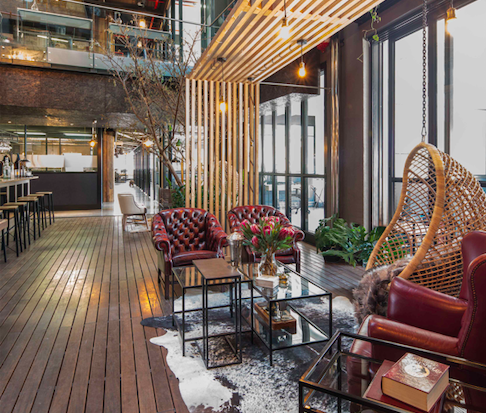Financial Mail Office
Creating Healthy Work Environments
Offering a healthcare insurance plan, however, is only the start of a true wellness programme, and more and more companies are finding that the design of a workplace can have a great impact on the culture and health of an organisation.
Christina Collett is an occupational therapist and member of the Absence, Incapacity and Disability team at specialist consultancy ICAS. She quotes a Harvard Business Review research paper, What’s the Hard Return on Employee Wellness Programs?, which found that employee wellness programmes can have a direct return on investment of up to 500% by reducing medical bills and days lost due to absenteeism.
“In a social context, optimal wellness culminates in the individual leading a purposeful life, forming meaningful relationships and developing self-regard and personal mastery,” explains Collett. “In a corporate context, they culminate in self actualisation of the individual which in turn will provide the organisation with the ability to achieve a competitive advantage.”
According to Collett, a healthy working environment encompasses more than just providing a wellness programme that helps to meet the basic needs of employees. It is also about creating a wellness culture within the organisation, including shared values, creating an environment of teamwork, trust, integrity and openness to share ideas without fear of retribution, so that employees are well both mentally and physically.
An integrated wellness programme typically includes occupational health, absence management, on-site clinics and gyms, fitness challenges, quit-smoking clinics and nutritional advice.
“Providing employees with fresh produce or fruit baskets daily can also promote healthy eating habits,” says Collett. “Other examples can include encouraging employees who are physically able to do so to utilise the stairs instead of lifts.”
Sensible ergonomics
Craig Hean is the CEO of commercial property and investment management firm JLL South Africa. In addition to wellness programmes, he believes that many design features like improved acoustics, lighting, ergonomics and thermal comfort are not only cost-effective and reduce environmental impact, but also have a remarkable impact on the health and productivity of people in the workplace.
Hean also advises employers to provide a range of innovative spaces in order to create happiness in the workplace, meet employees’ expectations and retain talent. “Our research found that to help employees cope with work pressures, respondents wanted non-traditional spaces for concentration, getting their energy back and finding ways to get them away from their desks,” explains Hean. “Employees need spaces for contemplation, community-focused spaces, health-based environments, and collaborative and experimental spaces.”
Hean cites a global survey conducted by JLL in 2017, Workplace: Powered by Human Experience, which showed that 50% of South African employees interviewed felt that there is a compelling case for companies to appoint a chief happiness officer (or equivalent) to shape employee experiences at work. Additionally, 77% of surveyed individuals ranked “happiness” as the biggest contributor to a unique work experience, compared to just 69% of global respondents.
At the desk
However much effort is put into the office environment, however, there’s no getting away from the fact that the majority of many people’s time will be spent at a desk, looking at a screen. It’s easy to overlook the basics of employee comfort here.
“We make the mistake of thinking that people are necessarily comfortable and efficient, but research shows that without ergonomic intervention over 80% of workers get more uncomfortable as the day progresses, resulting in reduced performance,” explains Gary Arenson, Managing Director of Ergotherapy Solutions. “If correctly implemented, with products that are practical and used correctly, ergonomics is a vital ingredient for companies that want to outperform the competition.”
Arenson suggests investigating standing desks. These are increasingly popular in South Africa, he says, although the ability to be able to both sit and stand for periods of time during the work day is important. “Internationally, (many) companies provide workers with the ability to stand and work as a standard,” says Arenson.
He points to a 2016 study by researchers at Texas A&M University which showed that call-centre employees who used standing desks for a six-month period were 46% more productive than those who operated at standard desks.
Arenson highlights the fact that standing desks make it possible for people to work in a way that promotes both productivity and general health, whether one is concerned about weight, cardiovascular disease, cancer, blood sugar or simply their back. “Standing as opposed to sitting all day will help your body burn an additional 170 calories per day,” he adds. “Conversely, sitting for extended periods of time is linked with obesity.”
Collett agrees, and adds that excessive sitting is unhealthy and has been linked to an increase in metabolic-related diseases. However, while there’s been a lot of hype around standing desks, with some employers even going as far as offering treadmill or cycling desks to employees to try and promote activity within the workplace, she warns that deploying standing desks in isolation will not contribute to employee’s overall physical wellbeing and general wellness.
“Standing without mobilising can lead to compression of the spine and swelling of the feet and ankles,” she says, adding that a height-adjustable desk can benefit employees, and that adapting work environments to best fit an individual’s needs can reduce musculoskeletal stressors on the body as well as improve overall output and productivity.
“Employees who are required to alternate between a sitting and standing position experience reduced levels of fatigue and their risk of injury caused by working in one position for too long is minimised.”






 Sign-up and receive the Business Media MAGS newsletter OR SA Mining newsletter straight to your inbox.
Sign-up and receive the Business Media MAGS newsletter OR SA Mining newsletter straight to your inbox.